The Definitive Guide to Geotheta
Wiki Article
Some Known Facts About Geotheta.
Table of ContentsGeotheta for BeginnersGeotheta Fundamentals ExplainedNot known Details About Geotheta 6 Easy Facts About Geotheta ExplainedThe Basic Principles Of Geotheta

They carry out website examinations, accumulate samples, carry out research laboratory examinations, and analyze data to assess the suitability of the ground for building tasks - Geo Tech Engineering. Based on their findings, geotechnical engineers offer suggestions for foundation layout, incline security, keeping structures, and mitigation of geotechnical dangers. They collaborate with various other experts, such as designers, structural engineers, and construction teams, to make certain that geotechnical considerations are integrated into the total job design and application
By assessing the behavior and residential properties of soil and rock, they can recognize possible geotechnical risks such as landslides, dirt negotiation, or incline instability. Their know-how assists protect against failings or mishaps that might endanger lives and property. Here are some thorough responsibilities and responsibilities of a geotechnical engineer: Website Examination: Geotechnical designers conduct website examinations to collect data on subsurface conditions.
They analyze the data to comprehend the buildings and behavior of the dirt and rock, including their strength, leaks in the structure, compaction qualities, and groundwater conditions. Geotechnical Analysis and Design: Geotechnical engineers examine the data accumulated during website examinations to evaluate the security and viability of the site for construction projects. They do geotechnical computations and modeling to assess factors such as bearing ability, negotiation, incline security, side earth stress, and groundwater flow.
The Best Strategy To Use For Geotheta
Structure Design: Geotechnical designers play a vital role in designing structures that can safely support the designated structure. They examine the soil problems and lots requirements to determine the appropriate structure kind, such as superficial structures (e.g., grounds), deep structures (e.g (https://www.mixcloud.com/geotheta/)., heaps), or specialized methods like dirt enhancement. They consider aspects such as settlement limits, birthing ability, and soil-structure communication to establish ideal foundation layoutsThey examine building strategies, monitor website activities, and perform field examinations to verify that the style suggestions are complied with. If unexpected geotechnical problems emerge, they examine the scenario and provide suggestions for removal or modifications to the design. Risk Assessment and Reduction: Geotechnical designers analyze geotechnical dangers and risks related to the task website, such as landslides, liquefaction, or soil disintegration.

Cooperation and Interaction: Geotechnical designers function closely with other experts entailed in a task, such as architects, structural engineers, and construction teams. Reliable interaction and cooperation are vital to incorporate geotechnical considerations right into the overall task style and building procedure. Geotechnical engineers give technological experience, answer inquiries, and make sure that geotechnical needs are satisfied.
3 Easy Facts About Geotheta Described
Here are some sorts of geotechnical engineers: Structure Engineer: Structure engineers focus on designing and analyzing structures for frameworks. They analyze the soil problems, tons demands, and website characteristics to figure out one of the most suitable foundation type and style, such as shallow foundations, deep foundations, or specialized techniques like heap structures.They review the factors influencing incline security, such as dirt properties, groundwater problems, and see here now incline geometry, and create methods to avoid incline failures and minimize threats. Earthquake Designer: Earthquake designers focus on analyzing and making frameworks to hold up against seismic forces. They evaluate the seismic hazard of a site, examine dirt liquefaction possibility, and develop seismic design criteria to make sure the safety and security and resilience of frameworks during earthquakes.
They carry out area testing, collect examples, and analyze the accumulated information to characterize the dirt buildings, geologic formations, and groundwater conditions at a website. Geotechnical Instrumentation Designer: Geotechnical instrumentation engineers concentrate on monitoring and gauging the actions of dirt, rock, and structures. They set up and preserve instrumentation systems that check aspects such as soil negotiation, groundwater levels, incline movements, and structural variations to evaluate performance and provide very early cautions of potential problems.
Fascination About Geotheta
They carry out examinations such as triaxial examinations, debt consolidation examinations, straight shear tests, and leaks in the structure examinations to collect information for geotechnical analysis and style. Geosynthetics Designer: Geosynthetics engineers concentrate on the layout and application of geosynthetic materials, such as geotextiles, geogrids, and geomembranes. They utilize these materials to boost soil stability, enhance slopes, offer drainage solutions, and control erosion.They often tend to be investigative individuals, which indicates they're intellectual, introspective, and inquisitive. They wonder, methodical, logical, analytical, and sensible. Several of them are likewise social, implying they're kind, charitable, participating, client, caring, handy, compassionate, tactful, and friendly. Does this seem like you? Take our complimentary profession test to locate out if geotechnical designer is one of your leading career suits.
In the office environment, geotechnical engineers make use of specialized software program devices to execute computations, develop styles, and assess information. They prepare reports, review job specs, communicate with customers and staff member, and coordinate project activities. The office setting gives a conducive environment for research study, analysis, and cooperation with other specialists entailed in the job.
All about Geotheta
They frequently check out project sites to carry out website examinations, assess geotechnical conditions, and gather information for analysis. These visits include traveling to different areas, in some cases in remote or challenging surfaces. Geotechnical designers might perform soil tasting, conduct examinations, and monitor building tasks to make sure that the geotechnical facets of the job are being applied properly.Geotechnical designers also function in specialized geotechnical research laboratories. In these facilities, they carry out experiments, execute tests on dirt and rock examples, and analyze the design residential or commercial properties of the products. Geotechnical laboratory designers work extensively in these environments, handling testing devices, running tools, and recording data. They work together with various other research laboratory staff to make certain exact and reliable testing outcomes.
Report this wiki page